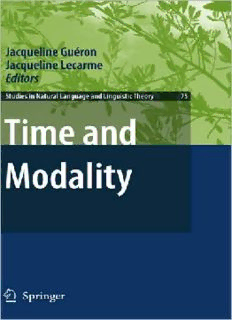Table Of ContentTIME AND MODALITY
Studies in Natural Language and Linguistic Theory
VOLUME 75
Managing Editors
Marcel den Dikken, City University of New York
Liliane Haegeman, University of Lille
Joan Maling, BrandeisUniversity
Editorial Board
Guglielmo Cinque, University of Venice
Carol Georgopoulos, University of Utah
Jane Grimshaw, RutgersUniversity
Michael Kenstowicz, Massachusetts Institute of Technology
Hilda Koopman, University ofCalifornia, Los Angeles
Howard Lasnik, University of Maryland
Alec Marantz, Massachusetts Institute of Technology
John J. McCarthy, University of Massachusetts, Amherst
Ian Roberts, University of Cambridge
For other titles published in this series, go to
www.springer.com/series/6559
TIME AND MODALITY
Edited by
Jacqueline Guéron
Université Paris 3, France
and
Jacqueline Lecarme
C N R S - Université Paris 7, France
Jacqueline Guéron Jacqueline Lecarme
Université Paris 3 - Laboratoire de Linguistique Formelle
Sorbonne Nouvelle CNRS - Universit éParis 7
France France
ISBN 978-1-4020-8353-2 e-ISBN 978-1-4020-8354-9
Library of Congress Control Number: 2008927066
© 2008 Springer Science + Business Media, B.V.
No part of this work may be reproduced, stored in a retrieval system, or transmitted in any form or by any
means, electronic, mechanical, photocopying, microfilming, recording or otherwise, without written
p ermission from the Publisher, with the exception of any material supplied specifically for the purpose
of being entered and executed on a computer system, for exclusive use by the purchaser of the work.
Printed on acid-free paper.
9 8 7 6 5 4 3 2 1
springer.com
ThecontributorstothisbookdedicateittoCarlotaSmith.
... ‘Ofearfulmeditation:where,alack,
ShallTime’sbestjewelfromtime’schestliehid?
Orwhatstronghandcanholdhisswiftfootback,
Orwhohisspoilofbeautycanforbid?
O,none,unlessthismiraclehavemight,
Thatinblackinkmylovemaystillshinebright’.
WilliamShakespeare,SonnetLXV
Preface
The papers in this volume were first presented at the International Round Table
Time andModalityheldin Parisin Decemberof2005andorganizedbythe Jeune
E´quipeB368Syntaxeanglaiseetsyntaxecomparative(Universite´Paris3-Sorbonne
Nouvelle)andbytheLaboratoiredeLinguistiqueFormelle(CentreNationaldela
RechercheScientifique(CNRS)andUniversite´Paris7).
We wish to thankthe institutionsthatprovidedfinancialsupportforthe Round
Table: the CNRS, the Laboratoire de Linguistique Formelle, the Conseil Scien-
tifique(Universite´sParis3andParis7)andtheBureaudesRelationsInternationales
(Universite´Paris3).
vii
Contents
Preface............................................................ vii
Contributors....................................................... xv
Introduction.................................................... 1
1 Tense ................................................... 2
2 Aspect .................................................. 3
2.1 PerfectandPerfectivity............................. 3
2.2 EventualityType .................................. 4
3 ModalsandModalVerbs................................... 5
3.1 Subject/SpeakerOrientation......................... 5
3.2 TheTemporalLocationofModalVerbs............... 6
3.3 TheTemporal/CausalFunctionofModalVerbs ........ 7
3.4 TheTemporalSyntaxofNon-RootModals ............ 8
3.5 WeakNecessityModals ............................ 9
4 TheRoleofPastMorphologyinModalContexts............... 9
5 TheSubjunctive .......................................... 10
6 Genericity ............................................... 11
7 CopularClauses .......................................... 11
8 ConclusionsandOpenProblems............................. 12
References..................................................... 14
PatternsintheSemanticsofGenericSentences ...................... 17
GregCarlson
1 TheSetting .............................................. 17
2 TheIssues ............................................... 18
3 InductionandStipulation................................... 22
3.1 RulesandInduction ............................... 22
3.2 WhatdoGenericSentencesdo? ..................... 23
3.3 InductiveGeneralizationsAgain ..................... 24
ix
x Contents
4 Patterns ................................................. 25
4.1 PatternsandNon-Patterns .......................... 25
4.2 GenericSentences................................. 27
4.3 Restriction ....................................... 31
4.4 ReviewofIssues .................................. 33
5 WeakandReallyStrongGeneralizations...................... 34
6 Conclusion............................................... 36
References..................................................... 37
IntensionalSubjectsandIndirectContextualAnchoring............... 39
IleanaComorovski
1 Introduction.............................................. 39
2 SpecificationalCopularClauses ............................. 40
2.1 Higgins’s(1973)TaxonomyofCopularClauses........ 40
2.2 TheSubjectofSpecificationalClauses................ 41
2.3 TheCopulaofSpecification......................... 42
3 RomanianQuestionsoftheFormCareCopulaDP? ............ 43
3.1 TwoTypesofDiscourse-Linking..................... 43
3.2 SemanticRestrictionsonthePostcopularDP .......... 44
3.3 RemarksontheSyntaxofRomanianQuestionsofthe
Form‘CareCopulaDP?’........................... 49
3.4 Conclusion....................................... 51
4 IndefiniteSubjects,Topichood,andPointofView .............. 52
4.1 IndefiniteSubjectsand Topichoodin Constituent
Questions ........................................ 52
4.2 Topichood,PointofView,andtheConditionalMood.... 53
5 Conclusions.............................................. 56
References..................................................... 56
TemporalOrientationinConditionals(Or,How I Learnedto Stop
WorryingandLoveUFO’s) ....................................... 59
BridgetCopley
1 UFOsandOtherOddities................................... 60
2 AwayfromanExplanation ................................. 65
3 TowardsanExplanation.................................... 68
3.1 NoRealEpistemicEventives........................ 69
3.2 AntecedentsHaveTheirOwnModalFlavors .......... 73
4 Conclusion............................................... 76
References..................................................... 76
OntheTemporalSyntaxofNon-RootModals........................ 79
HamidaDemirdacheandMyriamUribe-Etxebarria
1 Crosslinguistic Asymmetriesin the TemporalConstruals
ofNon-RootModals....................................... 80
2 TheGrammarofTemporalRelations......................... 82
2.1 TensesandAspectsasSpatiotemporalPredicates ....... 82
2.2 Anaphora ........................................ 84
3 Condoravdi(2002):PerfectModals .......................... 87
Contents xi
4 TheTemporalPhraseStructureofNon-RootModals............ 89
4.1 SettingtheModal-Time ............................ 89
4.2 OrderingtheModal-Time........................... 90
5 TheTemporalInterpretationofEnglishNon-RootModals ....... 91
5.1 Present/FutureOrientedEpistemicModals ............ 91
5.2 AspectuallyComplexModals:
ProgressiveandPerfectModals...................... 95
6 TheTemporalInterpretationofSpanishNon-RootModals.......104
6.1 ModalsInflectedforthePast ........................104
6.2 ModalsInflectedforthePresent .....................109
6.3 ModalsInflectedfortheFuture ......................110
7 Conclusions..............................................111
References.....................................................112
HowtoSayOught inForeign:The CompositionofWeakNecessity
Modals ........................................................ 115
KaivonFintelandSabineIatridou
1 ABasicContrast..........................................116
2 Weakness................................................117
3 TheCrosslinguisticPicture .................................120
4 Flavors ..................................................126
4.1 EpistemicModality................................126
4.2 Goal-OrientedModality ............................127
4.3 DeonticModality..................................127
5 Counterfactuality? ........................................128
6 AConsolationandaPrecedent ..............................131
7 ScopeConfusion?.........................................135
8 OrderingSourcePromotion.................................136
9 WhyCounterfactualMarking? ..............................139
10 Conclusion...............................................139
References.....................................................140
OntheTemporalFunctionofModalVerbs .......................... 143
JacquelineGue´ron
1 ModalVerbsPartI:GrammaticalProperties...................144
1.1 TheTenseofModals...............................144
1.2 AbsenceofAgreementMorphology..................146
1.3 TheTemporal/CausalFunctionofModalVerbs ........149
2 CausalityinGrammar .....................................149
2.1 TwoSyntacticLevelsofInterpretation................149
2.2 PointofView.....................................150
2.3 TheInstrument....................................150
2.4 TwoTypesofCausality ............................151
2.5 MetaphysicalCausalityonHighervPLevels...........161
2.6 OntheSyntacticDeterminationofCausality...........164
2.7 “MetaphysicalIntentionality” .......................167
Description:Time and Modality is a unique work of reference; not only does it unite studies which explore the syntax and semantics of tense or modality but it is the first book of its kind to embrace the interaction of tense and modality within a coherent generative model. Various topics are covered in this vol

